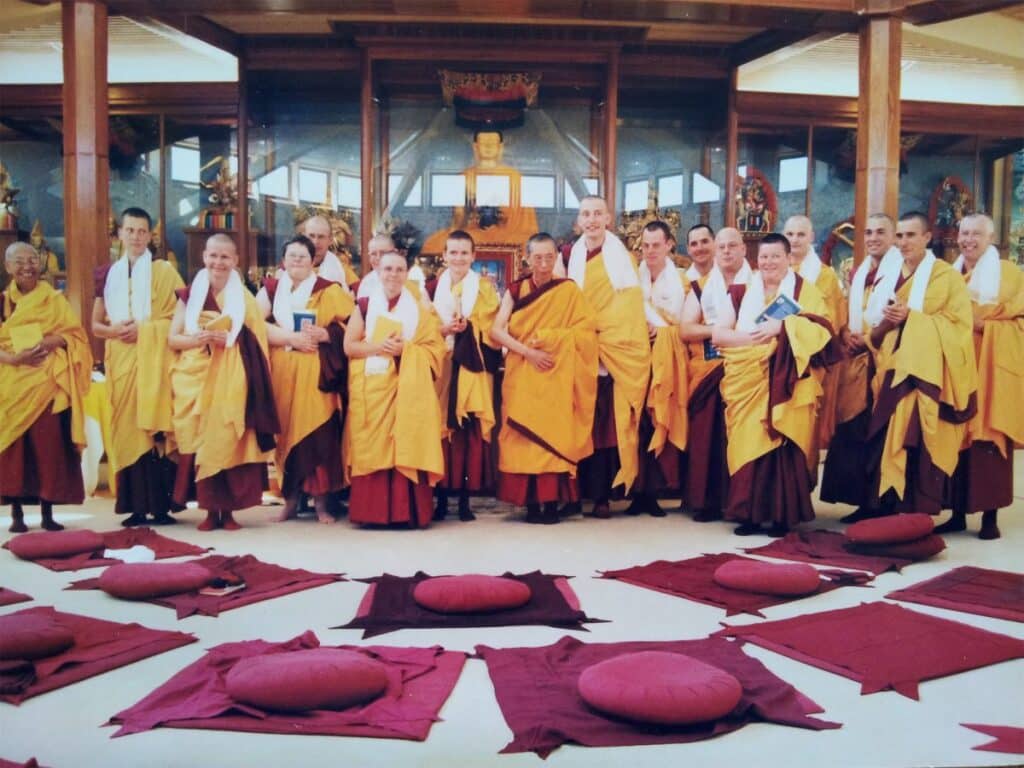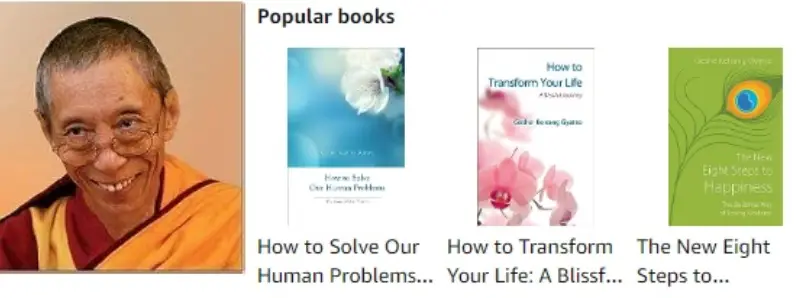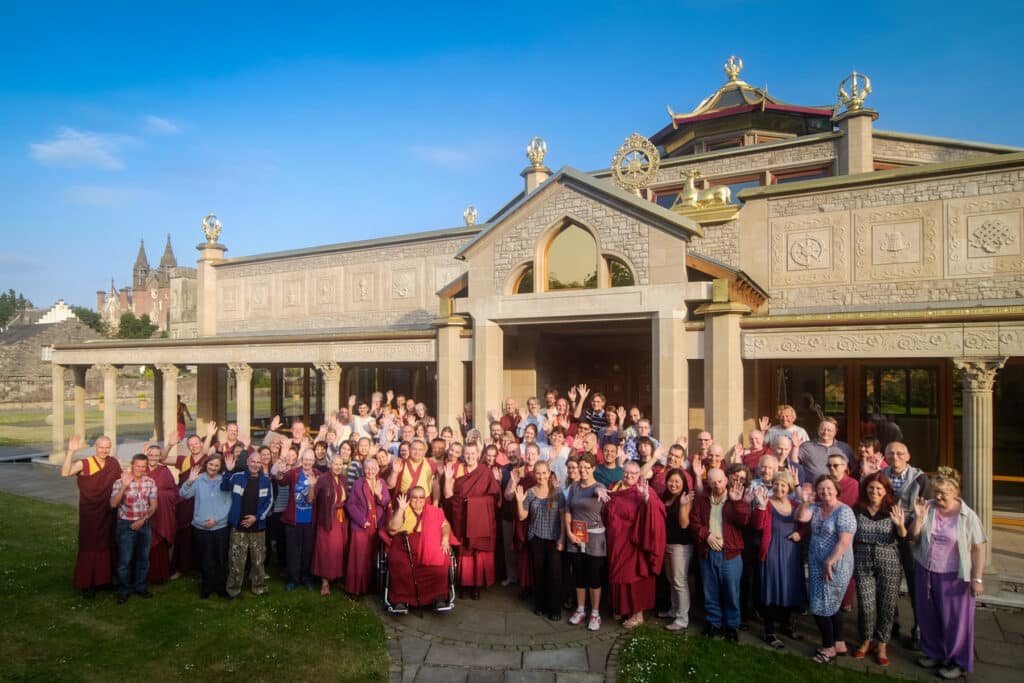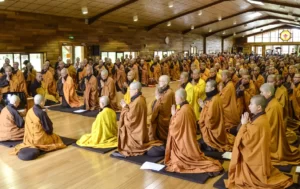Geshe Kelsang Gyatso, a towering figure in contemporary Buddhism, has been instrumental in making the ancient wisdom of Buddha accessible to the modern world. Born in a remote Tibetan village, he emerged from the harshest of conditions to become a revered teacher and prolific author, casting a profound impact on the global landscape of Buddhism.
His teachings, grounded in the Gelug school of Tibetan Buddhism, are uniquely crafted to cater to contemporary needs without compromising the core Buddhist tenets. As the founder of the New Kadampa Tradition – International Kadampa Buddhist Union (NKT-IKBU), Geshe Kelsang Gyatso has guided thousands of disciples across the globe, fostering a worldwide spiritual community that transcends cultural and geographical boundaries.
Who is Geshe Kelsang Gyatso?
Geshe Kelsang Gyatso (1931-2022) is an eminent Buddhist monk, scholar, and teacher hailing from Tibet. Born in Yangcho Tang, Eastern Tibet, he entered Jampa Ling Monastic School at a tender age and received a traditional monastic education. After a prolonged and arduous process of study and practice, he was conferred the title of “Geshe,” which implies “Virtuous Friend,” symbolizing a significant degree of scholarly attainment in Tibetan Buddhism.
A devoted disciple of Kyabje Trijang Rinpoche, the Junior Tutor to the 14th Dalai Lama, Geshe Kelsang Gyatso’s teachings are deeply rooted in the Gelug school of Tibetan Buddhism. This school, also known as the “Yellow Hat” tradition, was founded by Je Tsongkhapa (1357-1419), a seminal figure in Tibetan Buddhism whose reforms have profoundly influenced the landscape of Buddhism in Tibet.
Geshe Kelsang Gyatso left Tibet in 1959 following the uprising against the Chinese occupation and settled in India, where he continued his religious studies and practice. In 1977, he was invited to England to teach at the Manjushri Mahayana Buddhist Centre. His arrival in the West marked a new phase in his career, and he went on to become a prolific author and translator, dedicating his life to the propagation of Buddhism in the West.
Throughout his career, Geshe Kelsang Gyatso has authored over twenty books that articulate various aspects of the Mahayana Buddhist tradition. His works, ranging from introductory texts on meditation to comprehensive commentaries on Buddha’s sutras and tantras, have been translated into several languages, facilitating the global dissemination of Buddhist teachings.
In 1991, Geshe Kelsang Gyatso established the New Kadampa Tradition – International Kadampa Buddhist Union (NKT-IKBU), an international association of Mahayana Buddhist study and meditation centers. The NKT-IKBU has been instrumental in popularizing Buddhism in many countries, although it has not been without controversy, particularly with regard to its status within the broader Tibetan Buddhist tradition and its worship of the deity Dorje Shugden.
Geshe Kelsang Gyatso’s contribution to the worldwide spread of Tibetan Buddhism, especially the Gelug tradition, cannot be underestimated. His life and work encapsulate a profound commitment to religious practice, scholarship and teaching. His interpretations and representations of Buddhism, which are designed to cater to contemporary sensibilities, have played a crucial role in making Buddhist philosophy accessible and applicable for individuals beyond the confines of Tibet.
History of New Kadampa Tradition
The New Kadampa Tradition – International Kadampa Buddhist Union (NKT-IKBU), a contemporary school of Mahayana Buddhism, was established in 1991 by the Tibetan Buddhist scholar and teacher Geshe Kelsang Gyatso. This tradition draws its spiritual lineage from the Gelug school, also known as the “Yellow Hat” tradition of Tibetan Buddhism, founded by Je Tsongkhapa (1357-1419).
As LotusBuddhas shared above, following his move to England in 1977, Geshe Kelsang Gyatso undertook a series of teaching appointments at the Manjushri Mahayana Buddhist Centre. His tenure in the West marked a transformative period in his career, culminating in his establishment of the New Kadampa Tradition. The NKT-IKBU was conceived as a network of Mahayana Buddhist study and meditation centers, aiming to promulgate Buddhist philosophy and practices in the contemporary global context.
The NKT-IKBU is known for its focus on the practice of Kadampa Buddhism, a school of Mahayana Buddhism that emphasizes the integration of meditation and everyday life. It seeks to make Buddhist teachings accessible and relevant to individuals in the modern world, regardless of their cultural or geographic backgrounds. Central to the practice of the NKT-IKBU is the emphasis on the teachings of Je Tsongkhapa and the deity Dorje Shugden, seen as a protector of the Gelug tradition.
A significant feature of the NKT-IKBU is its broad transnational reach, made possible through the establishment of various study and meditation centers, retreat centers, and temples around the world. Geshe Kelsang Gyatso’s teachings have been foundational to the NKT-IKBU, with his books serving as core texts for study and practice within the tradition.
However, the NKT-IKBU has not been without controversy. Since its inception, it has been at the center of debates concerning its authenticity as a Tibetan Buddhist tradition. Notably, the tradition’s devotion to Dorje Shugden has been a point of contention, as the deity’s worship has been disputed within broader Tibetan Buddhism, especially by the 14th Dalai Lama and his followers.
Furthermore, the NKT-IKBU’s autonomy from Tibetan institutions and its claim of being an “authentic” Kadampa tradition, coupled with its Western orientation, has led to questions regarding its place within the larger Tibetan Buddhist tradition. Some critics argue that the tradition’s distinctive practices and beliefs diverge significantly from those of mainstream Tibetan Buddhism.
Despite these controversies, the NKT-IKBU continues to flourish, and its influence on the global landscape of Buddhism remains considerable. Its existence illustrates the complexities and diversities within contemporary Buddhism and underscores the dynamic nature of religious traditions as they adapt to new cultural and social contexts. The New Kadampa Tradition represents an intriguing fusion of ancient religious philosophies with contemporary societal norms, thus offering an interesting case study for scholars of religion, culture and globalization.
The teachings of Geshe Kelsang Gyatso
Geshe Kelsang Gyatso’s teachings are founded on the philosophy of the Gelug school, often referred to as the “Yellow Hat” tradition. His teachings, disseminated through numerous books and through the New Kadampa Tradition – International Kadampa Buddhist Union (NKT-IKBU) that he founded, center around several key principles.
- Buddha’s sutras and tantras: Geshe Kelsang Gyatso emphasizes the comprehensive study and practice of Buddha’s sutras and tantras. His commentaries provide in-depth explanations of these seminal texts, highlighting their applicability to modern life.
- Meditation and mind training (Lojong): A cornerstone of his teachings, Geshe Kelsang Gyatso advocates meditation as a practical means to attain enlightenment. He emphasizes the importance of understanding and controlling the mind as the foundation of Buddhist practice. His teachings often involve techniques for mind training (Lojong), promoting mental transformation by cultivating compassion and wisdom.
- Universal compassion and Bodhichitta: Echoing the Mahayana tradition’s focus, Geshe Kelsang Gyatso encourages the cultivation of universal compassion and Bodhichitta, the aspiration to achieve enlightenment for the benefit of all sentient beings. He believes that by developing a compassionate heart, individuals can lead more fulfilling lives and contribute positively to the world.
- Emptiness (Shunyata): As part of his teachings on Buddhist wisdom, Geshe Kelsang Gyatso elaborates on the concept of emptiness (Shunyata). He underscores the understanding of emptiness as fundamental to overcoming ignorance and attachment, and ultimately attaining Nirvana.
- Dorje Shugden practice: The worship of Dorje Shugden, a Dharma protector associated with the Gelug tradition, is a distinctive feature of Geshe Kelsang Gyatso’s teachings. He views Dorje Shugden as an enlightened being who helps practitioners protect their vows and commitments and advance on their spiritual path.
- Integration of Buddhism with daily life: Geshe Kelsang Gyatso insists on the integration of Buddhist practice into everyday life. His teachings are designed to provide practical solutions to life’s challenges, with an emphasis on inner peace and happiness.
His teachings represent a compelling blend of traditional Buddhist philosophy with contemporary needs and realities, offering a distinctive perspective within the diverse landscape of global Buddhism.
Books of Geshe Kelsang Gyatso
Geshe Kelsang Gyatso is a prolific author, having written and translated numerous books on Tibetan Buddhism. His works encompass a broad range of Buddhist teachings and practices, from introductory texts on meditation to in-depth commentaries on Buddha’s sutras and tantras. Below are some of his notable publications:
- “Introduction to Buddhism: An Explanation of the Buddhist Way of Life” (2001): In this accessible guide, Geshe Kelsang Gyatso provides an introduction to the core tenets of Buddhism, offering readers a fundamental understanding of the Buddhist way of life.
- “Universal Compassion: Inspiring Solutions for Difficult Times” (2002): This book provides a detailed commentary on Eight Verses of Training the Mind, composed by the Buddhist Bodhisattva, Langri Tangpa. It guides readers on the path of developing compassion and wisdom.
- “Transform Your Life: A Blissful Journey” (2001): Here, Geshe Kelsang Gyatso offers practical advice on how to transform daily life experiences into opportunities for personal growth and spiritual development.
- “How to Solve Our Human Problems: The Four Noble Truths” (2005): In this book, Geshe Kelsang Gyatso outlines the Four Noble Truths taught by Buddha, providing insights into the understanding and resolution of human problems.
- “The New Meditation Handbook: Meditations to Make Our Life Happy and Meaningful” (2003): As a practical guide, it offers instructions on various meditation techniques that aim to bring peace, harmony, and happiness.
- “Modern Buddhism: The Path of Compassion and Wisdom” (2010): In one of his most comprehensive works, Geshe Kelsang Gyatso presents the essence of Buddhist path as applicable to the modern world, including in-depth explorations of Sutra and Tantra.
- “Ocean of Nectar: Wisdom and Compassion in Mahayana Buddhism” (1995): This is a detailed commentary on Chandrakirti’s ‘Guide to the Middle Way’, seen as one of the most important texts in Mahayana Buddhism.
- “Heart Jewel: The Essential Practices of Kadampa Buddhism” (1997): The book details two essential Buddhist practices, namely a Guru yoga (practice of devotion to the Guru) of Je Tsongkhapa and a practice for relying upon the Dharma Protector, Dorje Shugden.
Geshe Kelsang Gyatso’s publications have played a crucial role in disseminating Buddhist teachings across the globe. They are often used as core study texts within the New Kadampa Tradition – International Kadampa Buddhist Union (NKT-IKBU) and have significantly influenced the tradition’s teachings and practices.
Buddhist centers associated with Geshe Kelsang Gyatso
Geshe Kelsang Gyatso, as the founder of the New Kadampa Tradition – International Kadampa Buddhist Union (NKT-IKBU), is associated with an extensive network of Buddhist centers across the globe. These centers focus on the study and practice of Kadampa Buddhism as interpreted by Geshe Kelsang Gyatso.
- Manjushri Kadampa Meditation Centre (MKMC): Located in the Lake District in the United Kingdom, the Manjushri KMC is the mother center of the NKT-IKBU. Originally known as Conishead Priory, it was where Geshe Kelsang Gyatso started teaching after arriving in England. It hosts a variety of courses, retreats, and festivals and houses the Kadampa Temple for World Peace.
- Kadampa Meditation Center New York City: Situated in the heart of New York City, this center offers an array of classes, workshops, and courses aimed at teaching meditation and Kadampa Buddhism. The center’s focus, like many in the NKT-IKBU, is to present Geshe Kelsang Gyatso’s teachings in a way that is applicable to everyday life, particularly within the urban context.
- Tharpa Publications: While not a center per se, Tharpa Publications plays a crucial role in disseminating Geshe Kelsang Gyatso’s teachings. Established by him, Tharpa Publications is the exclusive publisher of his books. It has offices in several countries and provides books, meditation CDs, audiobooks, and Buddhist art to individuals and Dharma centers worldwide.
- International Temples Project (ITP): The International Temples Project, established by Geshe Kelsang Gyatso, is a unique international fund dedicated to public benefit. The aim of the project is to introduce the Buddhist faith and practice of the New Kadampa Tradition publicly, and to show how individuals and society benefit from the integration of Buddha’s teachings into daily life.
- Other Kadampa Buddhist Centers: There are currently hundreds of Kadampa Buddhist centers and affiliated study groups located in cities and towns around the world. These centers provide a range of programs, including drop-in meditation classes, study programs, workshops, and retreats.
All of these centers are guided by the teachings of Geshe Kelsang Gyatso, and they seek to present Buddhism in a manner accessible and relevant to the modern world, with an emphasis on practical application in daily life. Despite the controversy and debates surrounding the NKT-IKBU, these centers continue to contribute to the globalization and diversification of Buddhism.
Some of Geshe Kelsang Gyatso’s famous quotes
Geshe Kelsang Gyatso is renowned for his insights and teachings on Tibetan Buddhism, many of which have been quoted extensively. Here are several of his most notable quotes:
- “Without inner peace, outer peace is impossible. We all wish for world peace, but world peace will never be achieved unless we first establish peace within our own minds.” – from “Transform Your Life: A Blissful Journey”
- “When the turbulence of distracting thoughts subsides and our mind becomes still, a deep happiness and contentment naturally arise from within.” – from “How to Transform Your Life”
- “Our task must be to free ourselves… by widening our circle of compassion to embrace all living creatures and the whole of nature and its beauty.” – from “Eight Steps to Happiness: The Buddhist Way of Loving Kindness”
- “If we want to experience true, lasting happiness, we need to learn the secret of inner peace by meditating.” – from “The New Meditation Handbook”
- “Every living being has the potential to become a Buddha, a person who has completely purified his or her mind of all faults and limitations and has brought all good qualities to perfection.” – from “Introduction to Buddhism: An Explanation of the Buddhist Way of Life”
- “All the happiness there is in this world arises from wishing others to be happy, and all the suffering there is in this world arises from wishing ourself to be happy.” – from “Modern Buddhism: The Path of Compassion and Wisdom”
These quotes offer a glimpse into Geshe Kelsang Gyatso’s teachings, particularly his emphasis on the importance of inner peace, the potential for personal transformation, and the interconnectedness of all beings. His insights continue to inspire and guide practitioners of Buddhism worldwide.
Controversy surrounding Geshe Kelsang Gyatso and NKT
Both Geshe Kelsang Gyatso and the New Kadampa Tradition – International Kadampa Buddhist Union (NKT-IKBU) he founded have been subject to controversy within the Buddhist community. These controversies primarily center around two interconnected issues: the tradition’s devotion to the deity Dorje Shugden and the NKT-IKBU’s perceived departure from mainstream Tibetan Buddhism.
- Dorje Shugden controversy: Geshe Kelsang Gyatso and the NKT-IKBU’s promotion of the deity Dorje Shugden, regarded as a protector of the Gelug tradition, has been a primary source of controversy. The 14th Dalai Lama discouraged the worship of Dorje Shugden, contending that it promotes sectarianism and is harmful to his personal wellbeing and the cause of Tibet. In response, Geshe Kelsang Gyatso and the NKT-IKBU have defended the practice, resulting in a longstanding and public dispute. This has led to divisions within the Tibetan Buddhist community and drawn international attention.
- Authenticity of the NKT-IKBU: The NKT-IKBU has been critiqued for its self-representation as an “authentic” Kadampa tradition and its separation from Tibetan institutions. Some argue that the NKT-IKBU’s teachings and practices diverge from those of mainstream Tibetan Buddhism, particularly in its approach to monasticism, the structure of its study programs, and its orientation towards Western practitioners. The tradition’s western orientation and its autonomous nature have led to accusations of ‘westernization’ or ‘dilution’ of Tibetan Buddhist practices and principles.
- Internal organizational issues: The NKT-IKBU has faced criticism regarding its internal organizational practices, including allegations of authoritarian leadership and issues related to the treatment of its members. Some ex-members have raised concerns about what they describe as an unhealthy environment within some NKT-IKBU centers, with claims ranging from psychological manipulation to inappropriate behavior. It is, however, you have note that experiences may vary widely across different centers and among individual practitioners.
While these controversies have been widely discussed, they do not diminish the significant influence that Geshe Kelsang Gyatso and the NKT-IKBU have had in making Tibetan Buddhist teachings accessible to a global audience. However, they do underscore the complexities and tensions that can arise when religious traditions move beyond their original cultural contexts and adapt to contemporary global realities.










